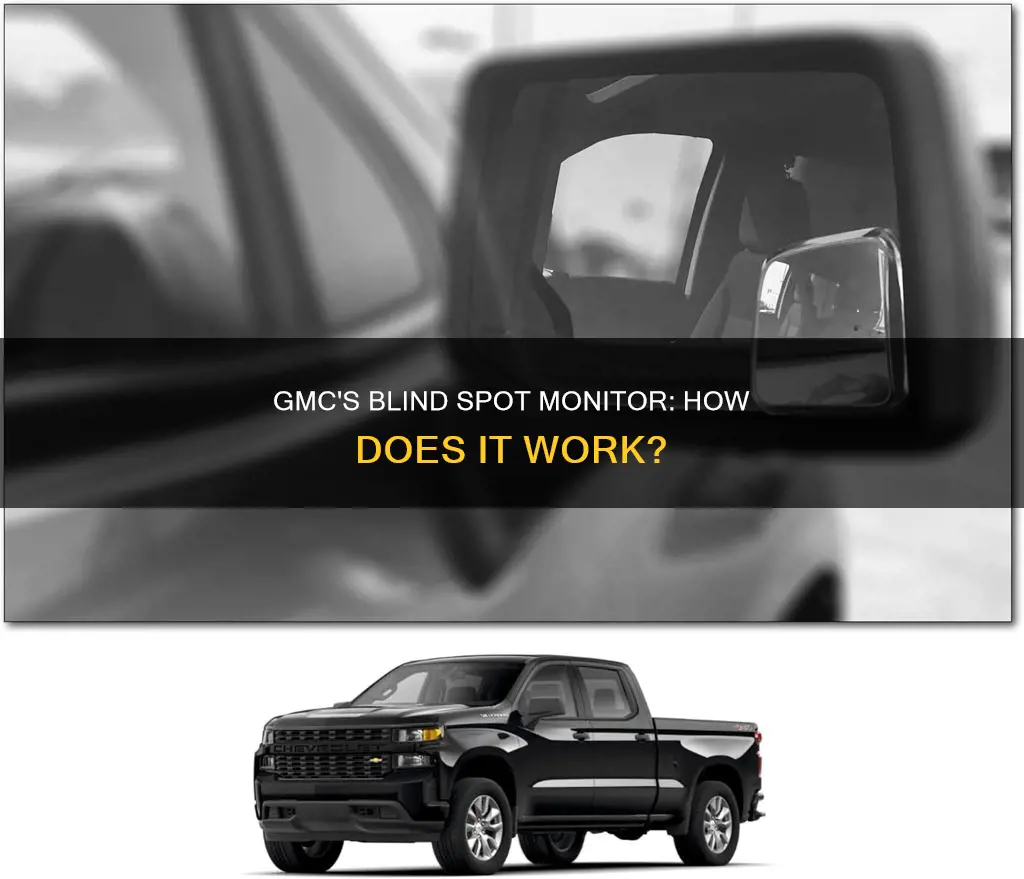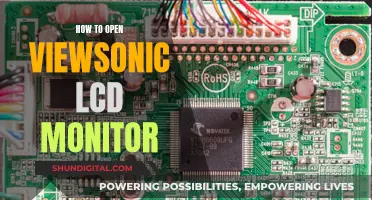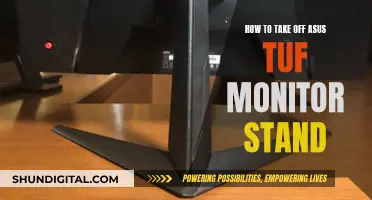
A blind-spot monitor is a safety feature that helps drivers become aware of potential hazards. It provides side-mirror visual alerts when a moving vehicle is detected in the driver's blind spot. GMC's Lane Change Alert with Side Blind Zone Alert uses hidden radar sensors in the rear corners of the vehicle to detect moving vehicles located behind the side mirror in the next lane over. The system is designed to detect most motorcycles but not pedestrians, bicyclists, or electric scooters. While a blind-spot monitor is a helpful feature, it is not a substitute for using mirrors and checking blind spots.
| Characteristics | Values |
|---|---|
| Purpose | To help drivers avoid lane-change collisions |
| Functionality | Provides visual alerts in side mirrors when a moving vehicle is detected in the blind zone or is approaching it |
| Sensor Location | Rear corners of the vehicle |
| Activation | When the vehicle is started, and when the feature is turned on |
| Alert Symbol | Amber warning symbol in the side-view mirror |
| Alert Symbol Flashing | When the turn signal is turned on in the direction of a detected vehicle |
| Customisation | Can be turned on and off through the Vehicle Personalization infotainment system menu |
| Limitations | Does not operate the brakes or steer the vehicle |
| Limitations | May not function as intended in bad weather or poor visibility conditions |
| Limitations | May light up a warning indicator due to non-moving objects like guardrails, signs, trees, and shrubs |
What You'll Learn

Lane Change Alert with Side Blind Zone Alert
Lane Change Alert and Side Blind Zone Alert are two parts of one feature that work together. When you start your vehicle or turn the feature on, you will see both side-view mirror alerts briefly light up, indicating that the system is working. While driving, if the system detects a vehicle in your side blind zone, an amber warning symbol will light up on the side-view mirror on the side where the vehicle has been detected. If you turn on your turn signal in that direction, the warning symbol will flash as an extra alert, indicating that it is not safe to change lanes.
This system uses hidden radar sensors in the rear corners of the vehicle to detect moving vehicles located in the blind spot of the driver, behind the side-view mirror in the next lane over. It is important to note that this feature only provides alerts and does not operate the brakes or steer the vehicle. Therefore, drivers should always remain attentive to their surroundings and use their mirrors and turn signals before changing lanes.
Additionally, under poor weather or visibility conditions, the system may not function as intended. To ensure optimal performance, it is crucial to keep the sensor areas in the rear bumper clear of any obstructions like dirt or snow. While this technology enhances safety, it does not replace the driver's responsibility to operate the vehicle safely and attentively.
Finding Your Monitor's Password: A Step-by-Step Guide
You may want to see also

How GMC's Blind Spot Monitor works
GMC's Blind Spot Monitor is a safety feature designed to assist drivers in changing lanes more safely and avoiding potential collisions. It consists of two main components: Lane Change Alert and Side Blind Zone Alert, which work together to provide drivers with visual alerts about the presence of vehicles in their blind spots.
Lane Change Alert uses hidden radar sensors in the rear corners of the vehicle to detect approaching vehicles in the adjacent lane before they enter the driver's blind spot. This feature is particularly useful when a vehicle is quickly approaching your lane change zone, as it helps you avoid potential lane change collisions.
On the other hand, Side Blind Zone Alert focuses on vehicles that are already in your blind spot. This system also uses radar sensors to monitor the areas beside and behind your vehicle, providing visual alerts when a vehicle is detected in the side blind zone.
When you start your GMC vehicle, both side-view mirror alerts will briefly come on, indicating that the system is active. Once you start driving, if a vehicle is detected in your blind spot or approaching your lane change zone, an amber warning symbol will light up on the corresponding side-view mirror. This warning symbol will flash if you turn on the turn signal in the direction of the detected vehicle, serving as an extra warning not to change lanes.
It's important to note that the Blind Spot Monitor system only provides alerts and does not intervene with steering or braking. Therefore, drivers should always remain attentive, use turn signals, and check their mirrors and blind spots before changing lanes. Additionally, the system may be affected by adverse weather conditions or obstructions like dirt or snow on the sensors, so it's crucial to keep the sensor areas clean and clear.
The Blind Spot Monitor is just one of the many advanced safety and driver-assistance features offered by GMC, all of which are designed to enhance your awareness and help prevent collisions while on the road.
Monitoring Data Usage: Netgear Routers and Devices
You may want to see also

Blind Spot Monitor sensors
The sensors are typically placed in the rear corners of the vehicle, monitoring the side blind zones. They detect moving vehicles located in the adjacent lane, outside the driver's peripheral vision. When a vehicle enters this monitored zone, the sensor triggers an indicator, alerting the driver.
The indicator is a crucial aspect of the system, usually in the form of visual LED lights and an audible alarm. These indicators are strategically placed within the vehicle cabin, ensuring the driver can easily see them without taking their eyes off the road.
It's important to note that while blind spot monitoring systems are valuable, they should not replace the driver's responsibility to use mirrors and check blind spots manually. These systems enhance safety, but drivers must remain cautious and attentive to their surroundings.
Additionally, some vehicles may have sensors located in the step cutouts in the rear bumper, as seen in the 2021 GMC Sierra. These sensors help detect side objects and are an integral part of the blind spot monitoring system.
Resetting Your ASUS Monitor's Colors to Factory Settings
You may want to see also

Aftermarket Blind Spot Monitors
There are two main components to an aftermarket blind spot monitoring system: the sensor and the indicator. The sensor uses technologies such as sonar, radar, and lidar to detect objects in your blind spot, while the indicator alerts you to potential hazards through visual and/or audio cues.
When choosing an aftermarket blind spot monitor, you'll find that many systems are universal, meaning they can be used regardless of your vehicle's age, make, and model. However, it's important to do your research as there are dozens of kit options available, and the indicators may vary between them. For example, some systems offer both visual and audio signals, while others may only have visual indicators.
Installing an aftermarket blind spot monitor can be done professionally or as a DIY project. If you choose to install it yourself, here are the general steps to follow:
- Place a calibration cloth behind your vehicle, aligning it with a measuring tape at a 90-degree angle.
- Use a level to create a vertical line on the vehicle's rear bumper.
- Remove the rear bumper and, if necessary, the taillights.
- Clean the calibrating positions in the inner rear bumper with rubbing alcohol.
- Place two magnets on the marked lines, one on the outside and one on the inside, to determine the sensor placement.
- Mark the spot inside the bumper where the magnet rests.
- Apply adhesive to the sensors and attach them to the inside of the bumper.
- Mount the LED indicators inside the cabin, ensuring they are easily visible without taking your eyes off the road.
- Adjust the volume of the indicator to ensure it's not too loud or startling.
It's important to note that even with a blind spot monitoring system, you should still use your mirrors and check your blind spots manually. These systems are designed to be an additional safety feature, not a replacement for cautious driving habits.
Simple Ways to Check Your Monitor's 155Hz Refresh Rate
You may want to see also

GMC Blind Spot Monitor issues
The GMC Blind Spot Monitor is a safety feature that helps drivers avoid lane change collisions. It provides visual alerts in the side-view mirror when a moving vehicle is detected in the driver's blind spot or is quickly approaching it. The system uses hidden radar sensors in the rear corners of the vehicle to detect moving vehicles in the adjacent lane.
Issues with the GMC Blind Spot Monitor
While the GMC Blind Spot Monitor is designed to enhance safety, there have been some issues reported by users. One common problem is the intermittent functioning of the monitor. Some drivers have reported that the passenger-side blind spot monitor works only about 75% of the time. In such cases, the monitor may fail to light up or provide an alert even when a vehicle is in the blind spot. This can be concerning as it may give drivers a false sense of security and lead to potential hazards.
Another issue with the GMC Blind Spot Monitor is that it can sometimes be triggered by non-moving objects such as guardrails, signs, trees, or shrubs. This can result in false alerts, causing confusion or distraction for the driver.
Additionally, the system may not function optimally under poor weather or low-visibility conditions. Obstruction of the sensors due to dirt or snow can also impact the accuracy of the blind spot monitor.
It is important to note that the GMC Blind Spot Monitor is an alert system and does not physically intervene to prevent collisions. Drivers are still responsible for operating the vehicle safely and should not solely rely on the monitor. Regular maintenance and keeping the system updated can help address some of these issues.
Hooking Up an RX 580: A Step-by-Step Guide
You may want to see also
Frequently asked questions
A blind spot monitor is a system that alerts you of potential hazards that you might not be able to see, increasing your driving awareness and response time.
The system uses sensors to constantly view the spots you can't always track while driving. When something enters the view of the sensor and you're travelling at a specific speed, the sensor triggers an indicator, notifying you of the hazard.
A blind spot monitor can assist drivers of larger vehicles, decrease stress levels, and prevent crashes.
While professional installation is recommended, you can install an aftermarket blind spot monitor yourself. The process involves marking the correct placement for the sensors, cleaning the calibrating positions, sticking the sensors in place, mounting the LED indicators, and adjusting the volume.







